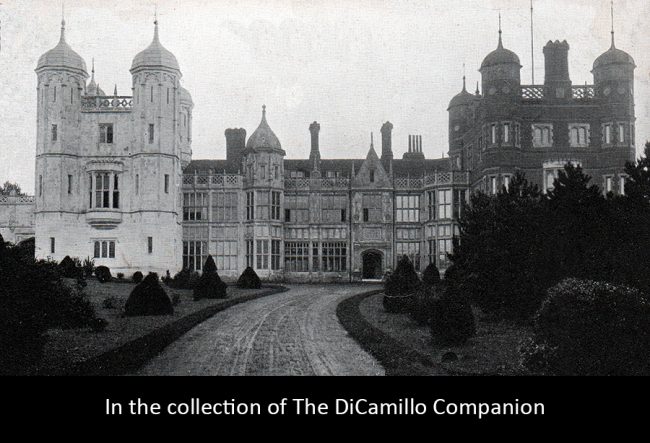
The House from a 1905 postcard
Built / Designed For: Cuthbert Quilter
House & Family History: During the Great War (World War I) the grounds and Stables of Bawdsey Manor were requisitioned by the Devonshire Regiment; the Estate was returned to the Quilter family after the War. In 1935 Bawdsey was selected by the government as the top secret location for a new research station for the development of radio direction finding. The Treasury allocated the enormous sum of £1 million (the equivalent of £63 million in 2016 inflation- adjusted values using the real price commodity index) for research on the new technology, soon to be called RADAR (RAdio Detection And Ranging). In 1936 the House, estate buildings, and 168 acres of land were sold to the Air Ministry and Sir Robert Watson-Watt (a direct descendant of James Watt, inventor of the steam engine) was appointed as superintendent. In January 1937 the Royal Air Force's Radio Direction Finding (RDF) training school was established here and the first chain home radar station was developed on the site, coming online in May 1937. It was at Bawdsey that Sir Robert and his team developed the radar technology that became essential to the defense of the United Kingdom against the vastly superior Luftwaffe during the Battle of Britain, with a chain of 57 radar stations that ran around the east and south coasts of England alerting the RAF of incoming enemy aircraft. Winston Churchill, writing about radar technology in "The Second World War": "All the ascendancy of the Hurricanes and Spitfires would have been fruitless but for this system which had been devised and built before the war." After the war, Bawdsey remained in the hands of the Ministry of Defence and became a training school, a purpose it served until 1990s, when it was sold into private ownership. Between 1994 and 2016 the House was home to Alexanders College, a boarding and day school. In 2000 the last of the transmitter masts at Bawdsey came down, though many of the other historic structures (receiver blocks, concrete transmitter blocks, and bunkers) are still in place and cared for by the Bawdsey Radar Group. In 2017 Bawdsey was sold to PGL Travel Ltd.; the property was reopened in 2018 by PGL as an adventure holiday venue.
Garden & Outbuildings: The gardens contain Elizabethan style pavilions with cresting. Across the Deben are two of the Martello Towers built to defend against invasion by Napoleon. The footprint left by a third tower today forms part of the formal gardens.
Title: Landmarks of Britain: The Five Hundred Places that Made Our History
Author: Aslet, Clive
Year Published: 2005
Reference: pg. 254
Publisher: London: Hodder & Stoughton
ISBN: 0340735104
Book Type: Hardback
Title: Burke's & Savills Guide to Country Houses, Volume III: East Anglia
Author: Kenworthy-Browne, John; Reid, Peter; Sayer, Michael; Watkin, David
Year Published: 1981
Reference: pg. 215
Publisher: London: Burke's Peerage
ISBN: 0850110351
Book Type: Hardback
House Listed: Grade II*
Park Listed: Grade II
Past Seat / Home of: Sir William Cuthbert Quilter, late 19th century; Quilter family here until the 1930s. James Adeane, 20th century.
Current Ownership Type: Corporation
Primary Current Ownership Use: Other
Ownership Details: Since 2018 owned and operated by PGL Travel Ltd. as an adventure holiday venue
House Open to Public: By Appointment
Phone: 03333-212-114
Website: https://www.pgl.co.uk
Historic Houses Member: No